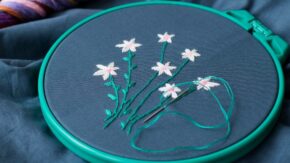Sculpture techniques involve making a piece of three-dimensional decorative art by carving, modeling, constructing, or casting a range or combinations of various media. You can use clay, stone, metal, wood, plaster, or a mixture of different media to work with to reflect your personal style and preferences.
Sculpture is one of the most primitive and ancient forms of art that traditionally used hard substances to create images, although modern artists use pretty much any medium that appeals to them.
There are many types of popular sculpting techniques, including casting, modeling, constructing, and carving. All these methods involve using certain tools and sometimes molds to create lifelike or abstract shapes. You can make a three-dimensional representation of your chosen subject or create a relief image.
To get started in sculpting, you must first choose what medium you want to work with. Next, you’ll need to set aside space in your home in which to work and gather the materials you’ll need for your new hobby. It’s helpful to join a local club or online community where you can learn the basics and then get started on a simple project. Be patient, learn from others, and don’t give up!
Before you know it, you’ll be creating gorgeous sculptures to delight and amaze your friends! Who knows, if you’re any good at your new craft, you could even use your passion to generate an income.
Read this guide to learn about the different sculpture techniques and styles and find out how to get started in this fascinating art form!
What Is A Sculpture?
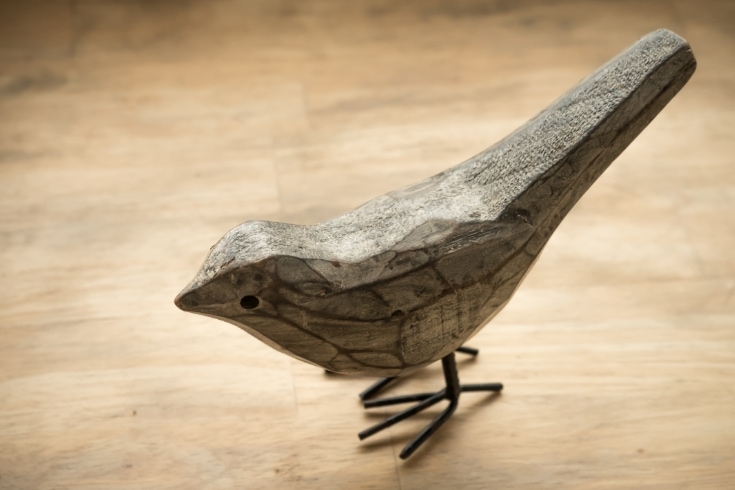
According to the dictionary, a sculpture definition is an ancient form of art in which hard materials are used to create decorative three-dimensional artworks. Sculpture can be freestanding, in relief on a surface, or even in an environment where the spectator is physically included as part of the display, for example, in a tableau.
A vast array of sculptor materials is used in this art form, including wax, clay, stone, wood, metal, plaster, glass, and other random objects. Sculpting methods use various techniques, including molding, casting, modeling, welding, assembling, carving, or a combination of those
A Brief History of Sculpture Through The Ages
The art of sculpting in its many forms dates back to ancient civilizations.
The earliest known sculptures were created during the Paleolithic era over 30,000 years ago and typically depicted animals and human figures. These early sculptors used stone, bone, wood, and ivory as their materials of choice, and their work was usually pocket-sized.
The ancient Egyptians created monumental sculptures to honor their gods and pharaohs, using limestone, sandstone, and granite to build pieces that are still standing today, such as the iconic Sphinx. The Ancient Greeks and Romans were renowned for their bronze and marble sculptures, emphasizing idealized human forms and proportions, depicting realistic anatomical features, and introducing contrapposto stances.
In India, China, and Japan, sculptures were often religious in nature, with Hindu deities and Buddha being common subjects for artworks carved in bronze, stone, and wood. With the advent of Christianity, sculpture became an integral part of Christian art, with relief sculptures adorning cathedrals and Gothic and Romanesque styles emerging, focusing on religious themes.
During the Renaissance period, classical Greek and Roman art saw a revival, with artists like Donatello and Michelangelo creating lifelike bronze and marble sculptures to reflect humanism and naturalism, with the emphasis firmly on anatomical accuracy. Baroque sculptures featured dynamic movement and dramatic intensity, while the Rococo period was characterized by playful, light, and more decorative pieces.
The Neoclassical sculptors returned to working with more classical forms and themes, placing an emphasis on symmetry and simplicity.
So, there’s plenty to inspire you if you decide to take up sculpture as a hobby!
What Is The Difference Between Sculpture And Statue?
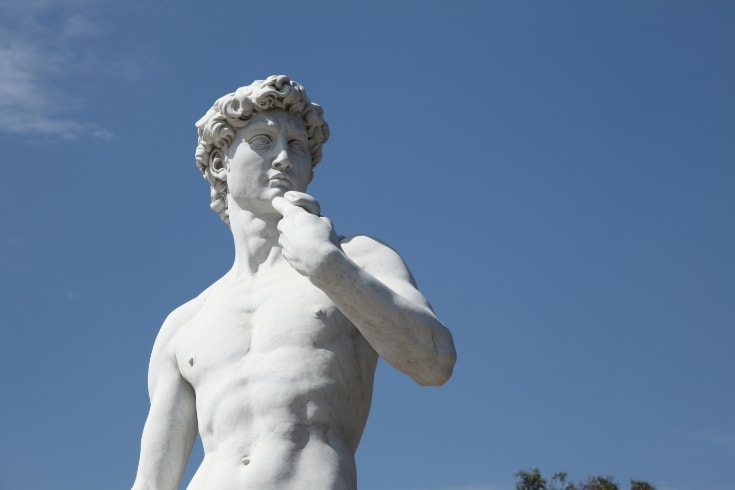
You might be wondering if there’s a difference between sculpture and statue! After all, surely these art forms are both pretty much the same, right?
The terms are often used interchangeably, but these two art forms have subtle differences, as we explain below.
Sculpture
- A sculpture is a three-dimensional piece of artwork.
- Sculptures are made from carving a solid piece of material, typically stone, clay, metal, or some other material.
Statue
- A statue is an artwork that depicts a person, part of the person, or an animal
- Statues are usually created by casting a mold to create several component parts that are then assembled, as in the case of the Statue of Liberty.
What Are The Different Sculpting Techniques?
The different sculpture techniques are explained in detail below, so you can decide what medium you would prefer to work with.
Bear in mind that some of these media and methods of sculpture demand quite a lot of storage space and a specialized working environment, so do take that into account when making your choice.
Carving
Carving is the technique of shaping a piece of solid material by using a tool to remove pieces of that material.
To carve a sculpture, you use a tool like a mallet, chisel, or gauge to remove unwanted fragments of material to create a shape or design. Carving requires lots of patience and precision, so it’s not a good choice for you if you like to see an immediate result!
Materials commonly used for carving sculptures include wood, stone, alabaster, bone, and soapstone.
Modeling
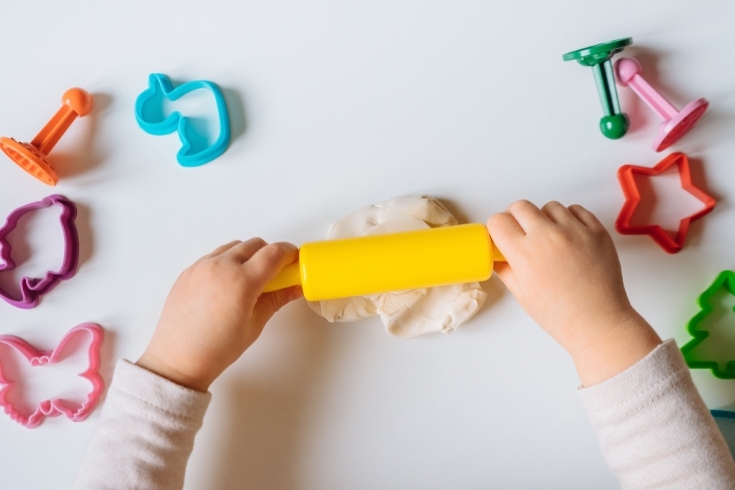
Cast your mind back to your childhood when you probably played with plasticine like I did. Well, that’s a form of modeling! Modeling is a form of sculpture that uses pliable materials and shapes them to create figures and forms.
You start with your base material, such as clay, and mold and shape it by hand or with tools to add or remove material to create the shape you want.
Popular materials for modeling include wax, clay, playdough, and, of course, plasticine!
Assemblage
Assemblage Is a rather random form of sculpture that involves creating a three-dimensional object using prefabricated components or bits and pieces you’ve found either in nature or around your home.
This form of sculpture is great for people who like to reuse or upcycle unwanted scrap items. To create your salvaged masterpiece, you can use glue, nails, and screws to fix your chosen materials together into your desired shape or design.
You can use pretty much anything to create an assemblage sculpture, including scrap metal, plastic items, and wood.
Casting
The casting process involves pouring liquid material into a mold, allowing the material to harden, and then breaking the mold to remove the solid material to reveal your final sculpture.
You start by creating or choosing a mold of the desired shape. Next, pour in your chosen liquid material, leave it to set, and remove the mold to reveal your cast sculpture.
Popular materials for casting sculptures include resin, plaster, bronze, and aluminum.
Constructing
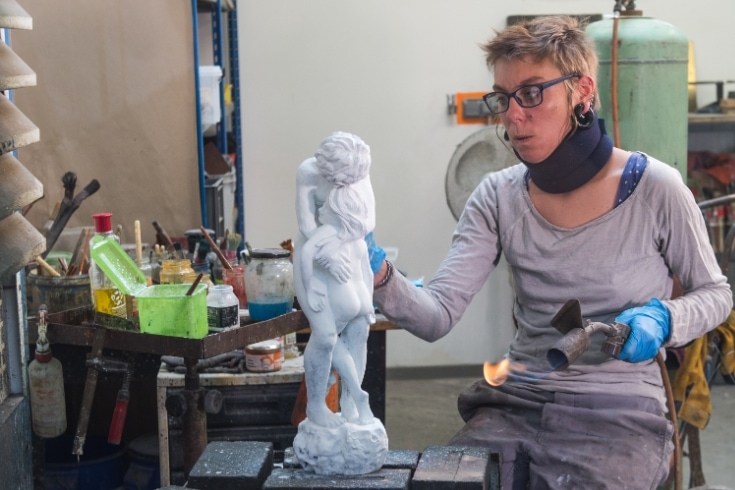
Constructing means creating a sculpture by combining different materials to build an object.
If you enjoy being very hands-on and you like basic DIY, this form of sculpture is perfect for you. You design a structure and then combine the various elements by welding, gluing, or using fasteners to fix them.
When it comes to choosing materials for construction, you could use metal sheets, plastic, wood, glass, or pretty much anything you like.
Relief Sculpture
A relief sculpture has all the sculpted elements fixed to a solid background projecting outward (high relief), inward (sunken relief), and (low relief), where the projection from a supporting background is shallow.
To create a relief sculpture, you must first carve, construct, or model your chosen materials so that the sculpted parts are raised from your background to create a three-dimensional effect on the flat surface.
Popular materials for this form of sculpture include wood, stone, metal, and clay.
Clay Sculpture
To create a clay sculpture, you must mold and shape the clay into a three-dimensional form. You do that by manipulating the clay by hand or with special sculpting tools to create the shape you want. Then, you harden your creation by air drying it or firing it in a kiln.
Several types of clay are available for this form of sculpture, including air-dry clay, polymer clay, and kiln-fire clay.
Stone Sculpture
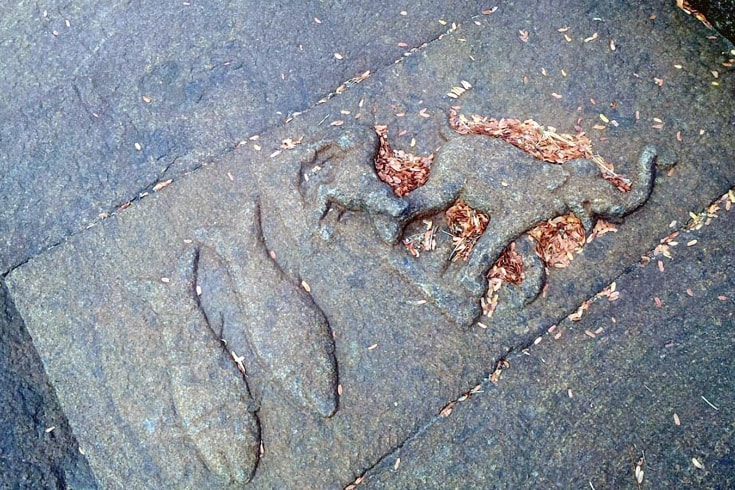
As you might guess from its name, stone sculpture involves carving and shaping pieces of stone to create three-dimensional forms.
To create a stone sculpture, you start with a nice piece of stone and use tools like hammers, chisels, and other specialist tools to carefully remove pieces of the material to reveal your desired design or shape.
There’s a wide range of different types of stone to choose from, including granite, marble, sandstone, and limestone.
Metal Sculpture
Creating a metal sculpture entails using metal materials to make a three-dimensional artwork. You can use any kind of metal for this kind of sculpture, including bronze, steel, aluminum, and copper.
To work with metal, you can use several techniques like cutting, welding, bending, and shaping your chosen material to construct your chosen design. Some people also use methods such as casting, forging, and fabrication, depending on what facilities you have available.
Wood Sculpture
Wood sculptures are three-dimensional artworks made from wood. To create a wood sculpture, you would use tools such as sores to carve the wood into your desired shapes and then use glue to assemble the pieces into the finished sculpture.
You can use any kind of wood for this form of sculpture, including softwood, hardwood, plywood, and even MDF.
Plaster Sculpture
Plaster sculpture uses casting or modeling to create three-dimensional forms made of plaster. To do that, you mix your plaster of Paris with water and pour it into a mold or apply it over an armature and allow it to harden to create your final artwork.
You’ll need plaster, water, and some kind of reinforcing material, such as burlap.
Mixed Media Sculpture
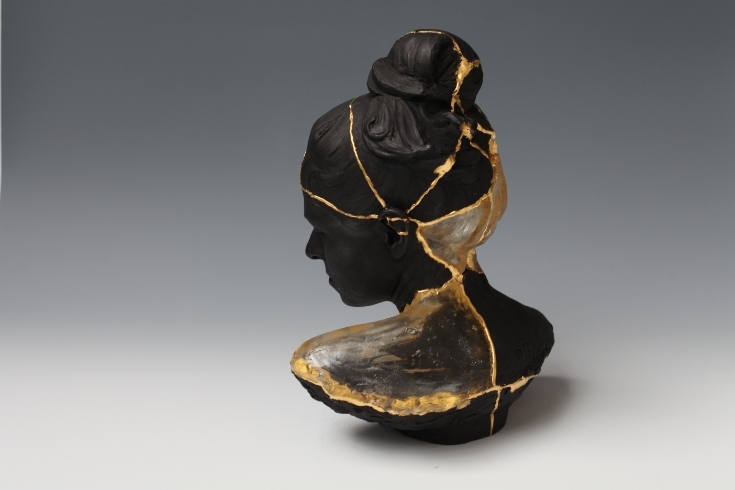
As you can guess from the name, mixed media sculpture uses various materials and techniques to create your three-dimensional artwork.
To create a mixed-media sculpture, you will need to combine a range of methods and materials to form a multi-dimensional work of art. You can use pretty much any materials you want, including metal, wood, plastic, and textiles.
What Are The Different Types Of Sculpture?
The different types of sculpture you can choose to specialize in include all those mentioned below. Of course, you could decide to try several different styles until you find the ideal style and medium to work in.
Additive Sculpture
Adjective sculpture involves adding materials together to create a finished piece. The materials are joined, built up, or layered without removing anything, generally starting from a core structure and adding elements until you get the form you want.
Materials used in additive sculpture include wax, cardboard, clay, metal, and wood.
Assembled Sculpture
Assembled sculptures are made by using pre-made components or objects you find and assembling them to create a new form. You can use any found objects, including scrap metal, wood, and plastic, fixed together using fasteners or glue.
Earthwork Sculpture

Earthwork sculptures use natural materials, such as soil, grass, sand, and rocks to create artworks from the earth itself. That can include creating structures using organic materials or modifying existing natural landscapes and typically involves large, outdoor, site-specific installations.
Installation Sculpture
Installation art involves building a three-dimensional sculpture or concept within an immersive space with the idea of transforming the perception of that space and asking viewers to use all their senses to appreciate it.
Kinetic Sculpture
Kinetic sculptures involve some form of movement. They are powered by the viewer, a motor, or the wind so that motion is incorporated as a basic aspect of the artwork. Materials used in this type of sculpture include plastic, wood, metal, and motorized components.
Sculpture In The Round
A sculpture in the round can be made from any sculptural material and is a free-standing, fully three-dimensional structure that can be viewed from all sides and not attached to a background like a relief.
Subtraction Sculpture
Subtraction sculpture involves removing material from an existing piece to reveal a final artwork, focusing on removal rather than addition. Popular materials for use in this technique include wood, stone, and ice.
Free-Standing Sculpture

A free-standing sculpture is very similar to a sculpture in the round in that it’s not attached to any background and is designed to be viewed from all angles. Again, pretty much any material, including wood, stone, metal, and clay, can be used to create this kind of sculpture.
Figurative Sculpture
This form of sculpture is used to represent specific objects rather than abstract pieces, with the human body being a particularly popular choice. You can use any kind of sculpting material to create a figurative sculpture.
Environmental Or Land Art
As the name suggests, environmental or land art refers to works that are created in and of the natural environment. These sculptures are very often site-specific and intended to create a harmonious blend of nature and art.
Materials used in environmental art include soil, rocks, water, and other organic materials.
Ceramic Sculpture
Ceramic sculptures use clay to create forms that are then fired to harden them. Various glazing techniques can be used to add your desired colors and finishes to your piece.
How Do I Get Started In Sculpting?
To get started in sculpting, you’ll need to decide what form of this fascinating art form you want to try your hand at. Before beginning sculpting, you must consider what space you have in your home, as some types of sculpture need quite a lot of floor space and might require large pieces of specialist equipment, such as kilns.
Here’s a more detailed overview of how to get started at sculpting and a guide to sculpting materials for beginners.
Choose Your Sculpting Medium
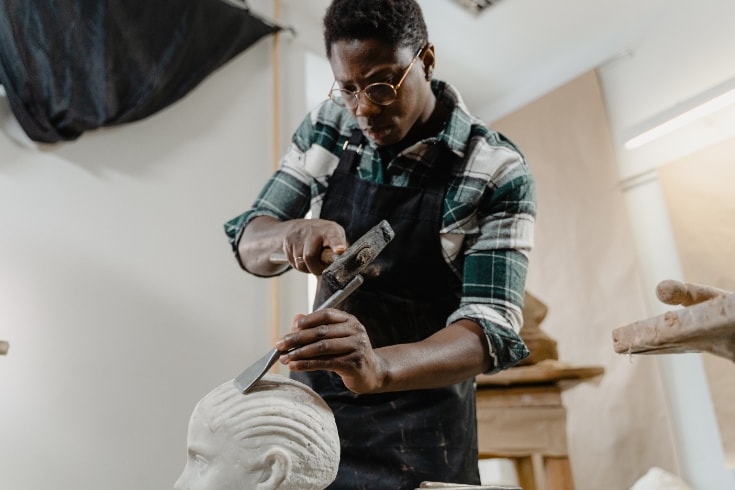
The first thing you will need to do is decide what style of sculpture you want to pursue and choose your preferred sculpting medium.
Gather Your Materials And Tools
Once you know what you are going to make, you can start to accumulate the tools and materials you’re going to need. As previously mentioned, do bear in mind what space you have at your disposal in your home because some forms of sculpture need a lot of room.
Storage space for your materials and finished artwork is also something to consider, especially if you want to get into working with metal and large pieces of stone.
Learn Basic Techniques
Don’t try to run before you can walk! Instead, start by learning the basic techniques of your chosen form of sculpture. There are some extremely helpful YouTube videos out there, not to mention plenty of books and informative websites for you to check out.
Find Inspiration
Of course, unless you have specific ideas on what you would like to create, you will need to look around to find inspiration. Art galleries, online exhibitions, and magazines can all be fertile grounds for getting your creative juices flowing.
Set Up A Workspace
Choose a dedicated area in your home or garage for use as a workspace and set it up accordingly. You might need to invest in a few cupboards and cabinets in which to keep your tools and materials, and you’ll need a suitable working area.
Ideally, you want a place where you won’t be disturbed or need to keep moving everything, especially if you’re working with casting sculptures that require time to set.
Start With Simple Projects
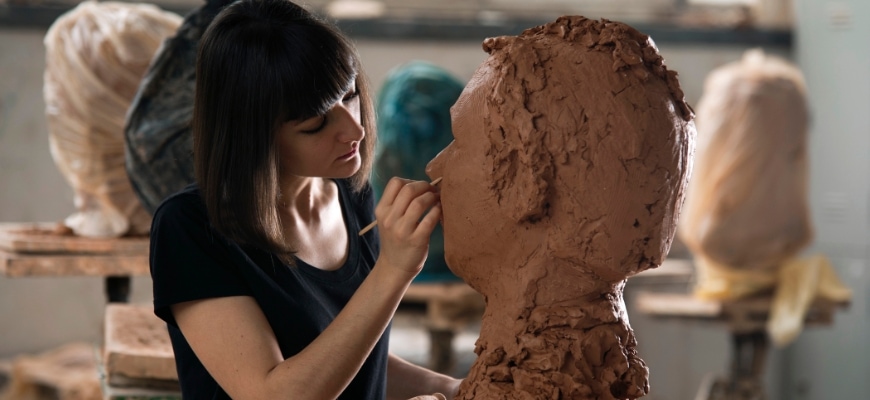
Again, don’t be too ambitious when you start your new craft. Start with simple projects and aim to complete them to the best standard you possibly can. That will give you the confidence and skills you need to move on to more challenging, complex pieces.
Study Anatomy And Form
If you plan to create sculptures of people and animals, take the time to study the anatomy and form of your subjects first. There have been many examples of woefully inaccurate wildlife sculptures, and you don’t want yours to be the next!
Experiment And Explore
As your skills develop, be prepared to experiment and explore new subjects and try using different media to create your sculptures. Although most people quickly find their preferred niche, there’s no harm in branching out and trying something different.
Learn From Others
You can accelerate the learning process by checking out what others are doing and learning from them. For that reason, we recommend joining a local club and searching online for forums that specialize in your chosen form of sculpture.
Patience And Persistence
As with any new skill, you must be patient and persistent, especially in the early days. You’re bound to make mistakes, but that’s just part of the learning process, so please don’t be disheartened if things don’t go exactly according to plan at the beginning of your sculpting journey.
Share Your Work
As your skills develop, it can be helpful to share your work with other artists and show it off to your friends and family. Who knows, you might even get to make a career out of this art form or at least generate a small additional income from it.
Continue Learning
As with any form of art, you never finish learning! Take every opportunity that comes your way to hone and improve your skills, try using different media, and learn new techniques. That all helps to keep your interest fresh and brings more enjoyment to your new hobby.
What Are The Benefits Of Learning Sculpture Arts?
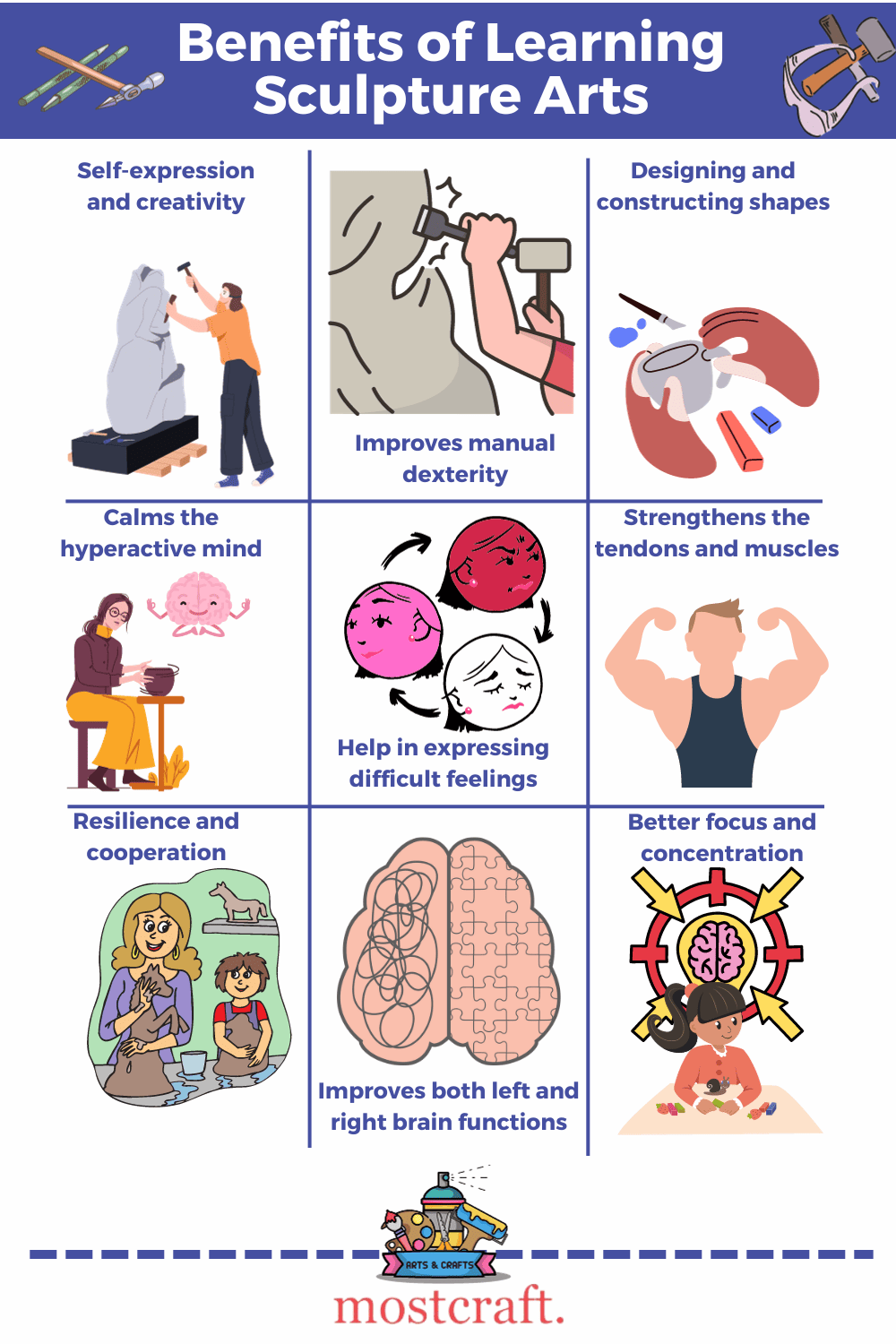
The benefits are undeniable when it comes to learning sculpture arts! As well as following in the footsteps of our ancient ancestors and helping to preserve age-old traditions and customs, you’ll be improving your manual dexterity and brainpower!
Keep reading to learn the benefits of taking up sculpture as a hobby.
Self-Expression And Creativity
Learning sculpture arts offers you a way of expressing your emotions, inner thoughts, and visions tangibly. Sculpture demands creativity since you are making pieces of three-dimensional art that reflect your feelings, imagination, and even personal experiences.
Improves Manual Dexterity
All forms of sculpting demand detailed and intricate work with your hands, promoting hand-eye coordination and helping to develop finer motor skills. That is especially important as you get older, helping to keep your fingers mobile and fending off joint stiffness and arthritis.
Designing And Constructing Shapes
Sculpting, by its very nature, involves designing and constructing shapes and forms. That requires excellent spatial awareness, planning, and a good understanding of geometry, balance, and proportion.
Calms The Hyperactive Mind
Many people who struggle to quieten a hyperactive mind find that sculpting has a calming and even meditative effect on them. The concentration you need to sculpt can bring a sense of peace and relaxation, helping to reduce anxiety and stress.
Help In Expressing Difficult Feelings
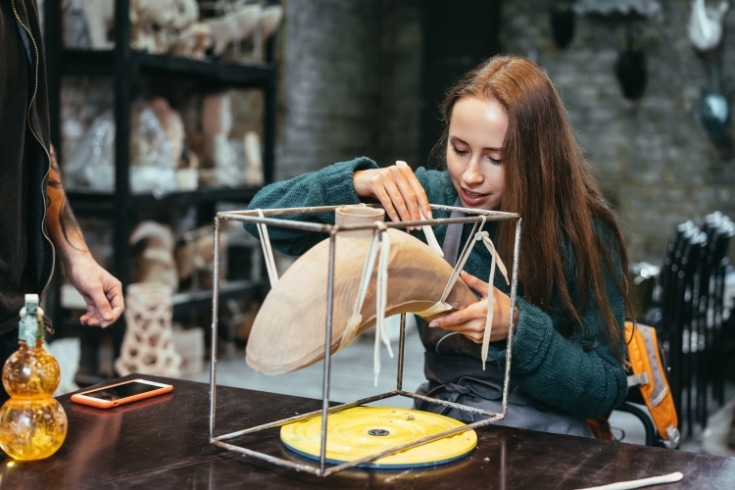
All art forms, including sculpture, allow you to express feelings that might be difficult to put into words. Creating sculpture can act as a form of non-verbal communication or emotional release that enables you to work through and reflect on distressing emotions and experiences.
Strengthens The Tendons And Muscles
The physical act of certain styles of sculpting, such as carving, modeling, or welding, makes you use various muscle groups and tendons. The repeated movements and the applied pressure when working with tough materials like metal, stone, and wood can strengthen your hands, arms, and other parts of your body, including improving your core strength.
Resilience And Cooperation
Sculpting often involves a degree of trial and error that requires patience, resilience, and persistence, especially when things don’t go as planned. In addition, good teamwork and cooperation between artists are essential when working in a shared studio or on a collaborative project.
Improves Both Left And Right Brain Functions
The art of sculpting stimulates both the brain’s hemispheres. Your brain’s analytical, logical left hemisphere helps you plan the work. In contrast, the more creative, intuitive right hemisphere is involved in your sculpture’s artistic expression and concept.
Using both sides of your brain can help promote cognitive development and balance.
Better Focus And Concentration
When you’re working on a piece of sculpture, you need to be able to focus on what you’re doing, especially when you’re busy shaping, carving, or assembling a piece of artwork. So, if you struggle to focus on concentrating at work, sculpting is the perfect hobby for improving that!
FAQs
In this part of our guide, we answer some of the most commonly asked questions about sculpting techniques, styles, and getting started in this fascinating and rewarding hobby.
What Are The Essential Sculpting Tools?
The essential sculpting tools you need depend entirely on the style of sculpting you want to take up and the medium you intend to use.
Here are some essential sculpting tools and their uses.
- Chisels and hammers: For carving hard materials like stone or wood.
- Clay modeling tools: For shaping and refining forms in clay.
- Wire tools: For cutting and shaping clay.
- Rasps and files: For shaping and smoothing wood or stone.
- Palette knives and spatulas: For mixing and applying materials.
- Calipers and dividers: For measuring and transferring proportions.
- Armatures: For supporting clay sculptures.
- Wooden modeling tools: For shaping clay or plaster.
- Loop and ribbon tools: For removing clay and smoothing.
- Safety equipment: Gloves, goggles, masks, etc., to give you protection while working with materials.
What Safety Precautions Should I Take When Sculpting?
Many forms of sculpture involve working in a dusty environment, especially if you’re using materials like stone or wood. In addition, chips of your material can fly off into your eyes, so you should wear safety goggles, gloves, and masks. Adequate ventilation is essential if you work with chemicals or materials that could emit harmful fumes.
Finally, keeping your workspace free from the clutter that you could trip over and using your tools carefully and correctly can help prevent accidents and keep you safe.
Can I Start Sculpting Without Any Prior Art Experience?
Yes, you can start sculpting without any prior art experience. However, a basic study of art concepts and techniques is a good idea, as is learning to understand anatomy, developing an eye for detail, and learning how to observe proportions.
That said, patience, persistence, and practice are easily the most important things you need to master sculpting. Remember, even renowned sculptors were once total novices without experience; everyone has to start somewhere!
What Are The Key Differences Between Classical And Contemporary Sculpting Techniques?
The key differences between classical and contemporary sculpting techniques usually lie in the style, material, and theme of the projects you might want to attempt. Contemporary sculpting is generally more diverse and experimental than the more rigid, balanced Styles of the classics.
How Can I Sell My Sculptures Online And Offline?
You can sell your sculptures through online platforms such as eBay, Etsy, or specialized art sales websites, and you could also use social media platforms to showcase and market your projects.
You could approach art galleries, take part in art fairs, or collaborate with local businesses that might display and sell your sculptures. Remember that high-quality photographs and sensible pricing are key to attracting potential buyers regardless of where you decide to sell your sculptures.
Are There Online Sculpting Courses Or Workshops Available?
Yes, there are plenty of online sculpting courses and workshops available on platforms such as Coursera, Skillshare, and Udemy, ranging from beginner to advanced level. These platforms give you access to a huge range of techniques and topics, and they allow you to study at your own pace and convenience.
What Are The Career Opportunities For Sculptors?
If you fancy pursuing a career as a sculptor, there are some career opportunities available. For example, you could work as an independent artist, collaborate with museums, or get involved in restoration work.
Some sculptures work in the gaming and film industry, creating prototypes and models, while others prefer to teach and pass on their skills to aspiring artists.
Conclusion
Sculpture has been around since ancient times as an art form and underpins many traditions in numerous civilizations around the world.
There are many different types of sculpture to choose from, using a wide range of techniques and materials. It’s really a case of choosing something that suits you, bearing in mind what space you have to work with and your budget for materials and tools. You can work with metal, wood, stone, and even reclaimed materials, depending on your preference.
Sculpting is great for your mental and physical health, as well as allowing you to express yourself and get creative. Some artists choose to sell their work to generate income, whereas others use sculpting as a form of relaxation and recreation.
Why not join a sculpting course to find out what form of this engrossing, challenging hobby is the best choice for you?



